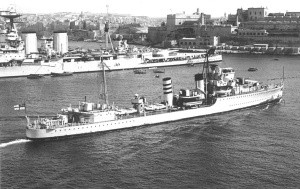 HMS Inglefield, with HMS Hood in the background
| |
| History | |
|---|---|
| Name | Inglefield |
| Namesake | Admiral Sir Edward Augustus Inglefield |
| Ordered | 14 November 1935 |
| Builder | Cammell Laird, Birkenhead |
| Laid down | 29 April 1936 |
| Launched | 15 October 1936 |
| Commissioned | 25 June 1937 |
| Identification | Pennant number: D02/I02 |
| Motto | The sun my compass |
| Honours and awards |
|
| Fate | Sunk by German Hs 293 glide bomb, 25 February 1944 |
| Badge |
|
| General characteristics (as built) | |
| Class and type | I-class destroyer |
| Displacement | |
| Length | 330 ft (100.6 m) (o/a) |
| Beam | 34 ft (10.4 m) |
| Draught | 12 ft 6 in (3.8 m) |
| Installed power |
|
| Propulsion | 2 shafts; 2 geared steam turbines |
| Speed | 36 knots (67 km/h; 41 mph) |
| Range | 5,500 nmi (10,200 km; 6,300 mi) at 15 knots (28 km/h; 17 mph) |
| Complement | 175 |
| Sensors and processing systems | ASDIC |
| Armament |
|
| Service record | |
| Operations: |
|
| Victories: | Sank U-45 (1939) and U-63 (1940) |
HMS Inglefield was an I-class destroyer leader built for the Royal Navy that served during World War II. She was the navy's last purpose-built flotilla leader. She was named after the 19th century Admiral Sir Edward Augustus Inglefield (1820–1894), and is so far the only warship to carry the name of that seafaring family. In May 1940, her pennant number was changed to I02.